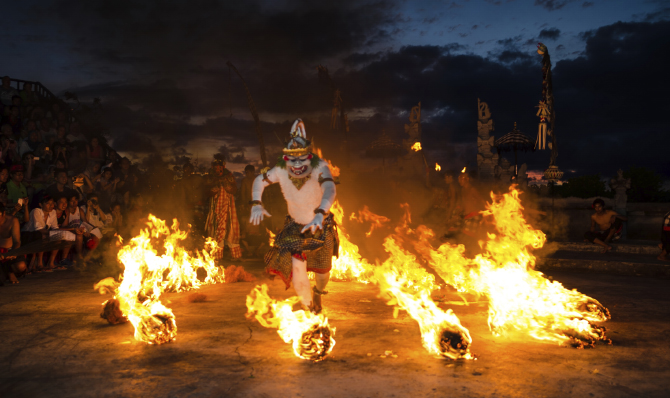Kecak and Fire Dance
Kecak and Fire Dance or 'Tari Kecak', is a captivating traditional Balinese art performance, which also goes by, ‘the monkey chant dance’, and loosely 'fire dance', for its occasional use of fire as a centrepiece prop. The Kecak was created around 1930 and is now internationally recognised as one of Bali’s top-three signature dances (alongside the Barong and Legong).
The Kecak and Fire Dance is unique in that it has no other musical background or accompaniment besides the chanting of male dancers, intoning a “keh-chack” polyrhythmic choir during most of the performance. Kecak’s storyline is taken from the Ramayana Hindu epic and it’s often on the entertainment schedule of almost every Balinese arts and culture venue.

What makes the Kecak and Fire Dance special is that the accompanying music is provided by the human voice, the gamelan suara, a choir of a hundred men or more sitting in concentric circles, swaying, standing up, lying prone as the story develops.Amongst the swaying masses the voices of the storytellers can be heard telling the unfolding tale.
The story is a fragment from the Ramayana, the Hindu epic which finds its expression in many forms, not only in dance, but also in painting and carving. Prince Rama, heir to the throne of the kingdom of Ayodya, and his wife Sita have been banished from the kingdom by King Dasarata as a result of trickery by Rama’s stepmother. The story begins with the arrival of Rama and Sita accompanied by Rama’s brother Laksmana in the forest of Dandaka.
The dance narrates the kidnapping of Sita by the evil demon-King Rahwana and her rescue by her husband with the help of Hanoman and his army of monkeys. This performance in particular is based on episodes around that the time when the Situbanda Bridge has been completed; Rama, his brother Laksamana, Hanoman, accompanied by his monkey army under the leadership of Sugriwa attack the Kingdom of Alengka, aiming at destroying Rahwana and rescuing Sita from his clutches.
Good to Know abou Kecak and Fire Dance
Kecak and Fire Dance actually originated from a Balinese ancient ritual called 'sanghyang' in which dancers fall into a trance. It is also a form of an exorcism and can go on for hours or even months. The ritual used to only take place inside temple grounds.
In 1930, a German artist, Walter Spies, created a touristic dramatic version of the 'sanghyang' by adopting the Ramayana epic as well. He worked together with Balinese dancer Wayan Limbak, and took their innovation on a world tour. Kecak shot to fame. The Kecak dance has been developed and modified since the 70s. Some performances now use a different storylines from another part of the Ramayana epic and some use a female Kecak chorus.
Best venues to watch the Kecak and Fire Dance are at Uluwatu Temple. Other performances can be found easily all over Bali, such as at the GWK Cultural Park, Pura Dalem Ubud, the Padang Tegal Stage, Batubulan, the Umadewi Stage, and many others. Kecak performances in the Gianyar regency are usually more spiritual-oriented than dramatic.
Kecak and Fire Dance Schedule and Ticket Price
The Kecak and Fire Dance shows last between 50 minutes and an hour, and the end of the show features photo taking onstage with the performing cast in their full costumes, as well as with the gamelan orchestra. Dances show once daily, usually starting in the afternoon, between 18:30 and 19:30. Tickets are IDR 100,000 per person. Most of Bali tour packages include this show on their itinerary.
-
Address: Uluwatu Temple, Bukit Peninsula, Badung Regency, Bali, Indonesia.



